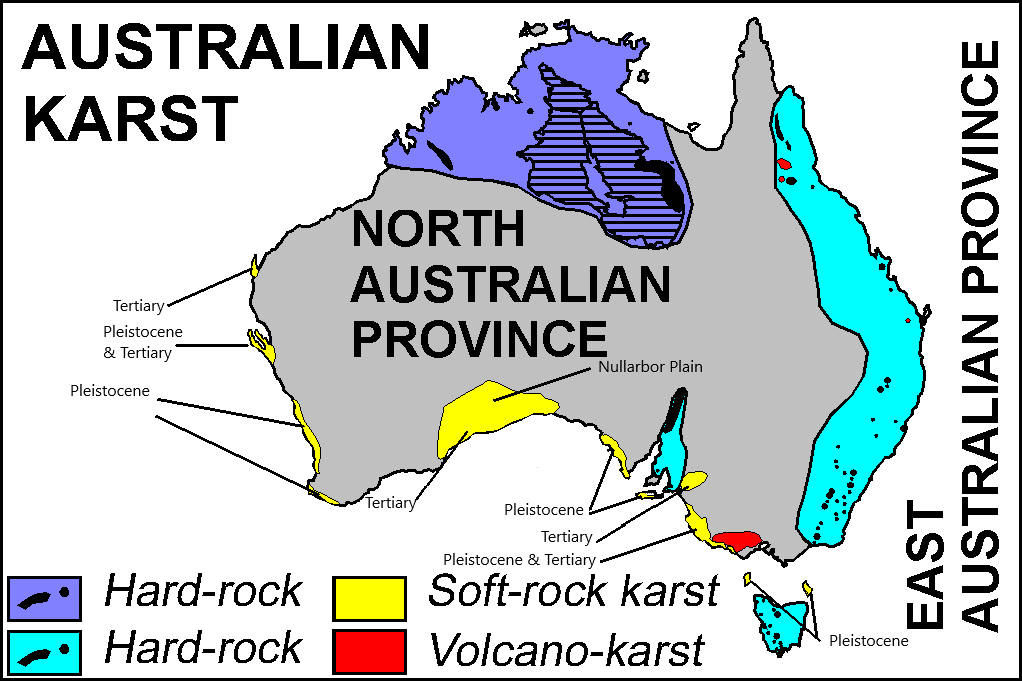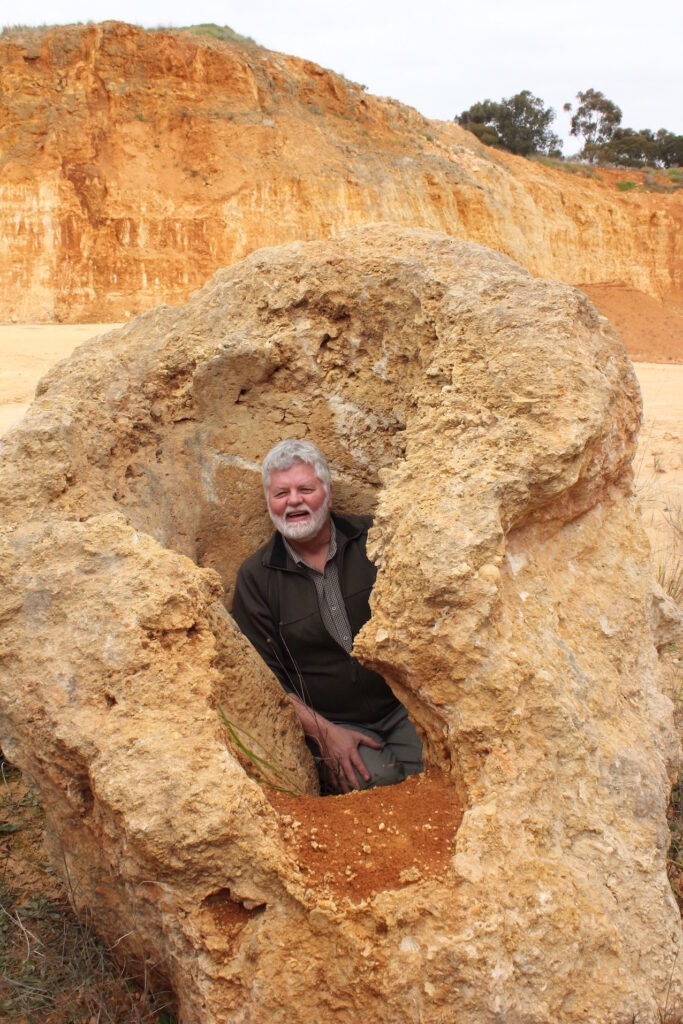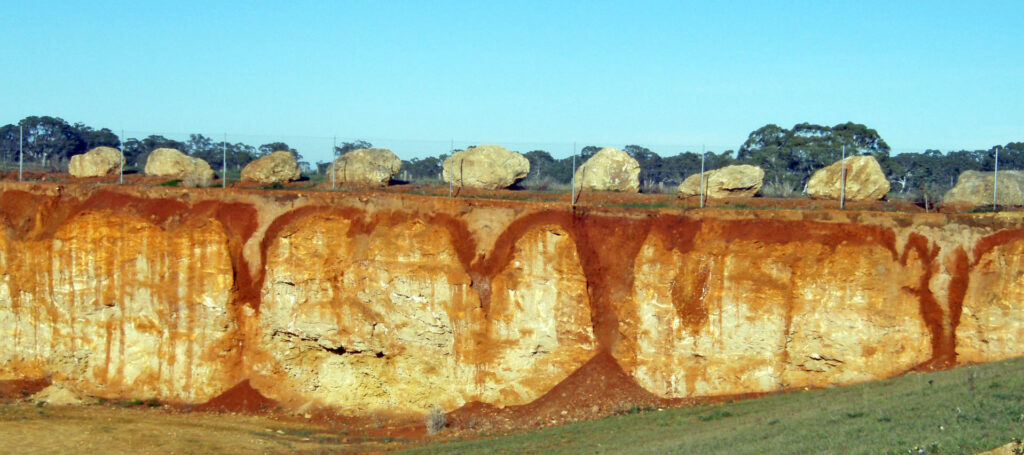
Andy Spate, AM
Extract from National Rock Garden Newsletter No. 23, May 2022
Australia has significant suites of rocks dating from the Eocene Epoch through to virtually the present (Holocene Epoch)—more than 120 Ma (Ma = million years) younger than the youngest in the NRG collection. The young rocks I am most interested in are the limestones shown in yellow on the map in Figure 1.
Let’s start with some silly statistics: the average age of rocks currently on, or ready for, display in the NRG is 947 Ma. The oldest is ~2700 Ma, the youngest is Mt Gibraltar Microsyenite at 178 Ma. The median is 430 Ma. Let’s have something like the Nullarbor Limestone at about 16 Ma and a piece of the aeolian calcarenite at about 0.2 Ma!
| Unit | State/Territory | Age (Ma) |
|---|---|---|
| Tumbiana Formation | WA | 2700 |
| Boogardie Orbicular granite | WA | 2686 |
| Brockman Iron Formation | WA | 2450 |
| Mt Goyder Syenite | NT | 1825 |
| Oolano Metasomite | SA | 1760 |
| Mawson Charnockite | Antarctica | 954 |
| Bendigo metasandstone and Ballarat quartz | Vic | 480 |
| Canberra Limestone | ACT | 430 |
| Adelong Norite | NSW | 430 |
| Middledale Gabbroic Diorite | NSW | 417 |
| Chinaman Creek Limestone | Qld | 407 |
| Moruya Tonalite | NSW | 379 |
| Tarana Granite | NSW | 312 |
| Bulahdelah alunite | NSW | 275 |
| Hawkesbury Sandstone | NSW | 247 |
| Tasmanian Dolerite | Tas | 179 |
| Mt Gibraltar Microsyenite | NSW | 178 |
| Marlborough chrysoprase | Qld | Uncertain |
Two suites of important younger rocks are not yet represented in the National Rock Garden. Both of these are of international significance as I will outline below.
Firstly, some 220,000 km2 of limestones of Oligocene to Miocene age can be found on the Nullarbor Plain (more than 3% of Australia’s land area) and the surrounding Eucla Basin. The sequence includes the Pliocene/Pleistocene Roe Calcarenite as well as at least five limestone units spread across the Basin both stratigraphically and spatially. The karst* features and related values—including very significant megafaunal remnants and interesting younger faunal records are outstanding. There are also highly significant anthropological and archaeological sites. It has been argued that the Nullarbor Plain is of World Heritage significance (Davey et al 1992—see reference note). However, the proposal to list it was confounded by differing land management practices in South Australia and Western Australia.
*Karst is a distinctive topography in which the landscape is largely shaped by the dissolving action of water on carbonate bedrock (usually limestone, dolomite, or marble).

Similar aged limestones can be found in south-east South Australia and western Victoria hosting such sites as the World Heritage Naracoorte Caves, celebrated for their vertebrate sub-fossil assemblages. These limestones are often overlain by the much younger limestones described below.
An extensive suite of young limestones, dating to the Quaternary Epoch, is found along the coasts of Western Australia, South Australia, Victoria, Tasmania and on Lord Howe Island off the New South Wales coast. These limestones are dune limestones—formed by calcareous sands blown off the sea floor during glacial sea level lows. Australia has more of these aeolian calcarenites than elsewhere around the globe. And possibly more caves than the rest of the world? Again, they contain significant past-climate and bushfire records, as well as sub-fossil faunas, invertebrate faunas, anthropological and archaeological values. As at Naracoorte and in the Gambier area, show cave attractions make a significant contribution to the local tourism economies from Margaret River to Yanchep north of Perth.
Neither of these limestone types are represented as yet in the NRG collection although there is a piece of the 18 Ma Naracoorte Limestone awaiting transport to Canberra. We need both this specimen and some examples of the aeolian calcarenites as well as the Nullarbor limestones for Canberra to emphasize that not all of Australia is super old!

Where might we get samples of these younger limestones to place in the National Rock Garden? As shown in Figure 2, we do have a sample of the Naracoorte Limestone Member awaiting transport to Canberra from Henschkes Quarry, Naracoorte, SA. The non-profit Australasian Cave and Karst Management Association Inc. (ACKMA) has pledged $1000 to help support the move to Canberra.

Obtaining a sample from the Nullarbor presents far more difficulties. The obvious starting point might be the roadside quarries along the Eyre Highway—but is the lifting and trucking equipment available? The other place might be the Rawlinna Limestone Member (Miocene) at the Loongana Quarry on the Trans-Continental Railway. Whilst this unit does not have some of the karst-related values of other Nullarbor limestone units it could still make its point.
Fragile specimens of the young calcarenites of the Bridgewater Formation from South Australia and Victoria could be obtained from quarries in those regions. But again, we need someone in those places to find a sample. Another candidate calcarenite is the Tamala Limestone in Western Australia, which is of particular historic significance, being one of the rocks that was described and studied by mineralogists aboard the 1801–03 French expedition of discovery, led by Nicholas Baudin (Mayer 2009). ACKMA may well support the transport of a sample from the Nullarbor and/or one of the calcarenites.
Acknowledgements
The author would like to thank Ian Lewis and Brad Pillans for their very useful input to this article.
References
Davey A.G., Gray M.R., Grimes K.G., Hamilton-Smith E., James J.M. and Spate A.P., 1992. World Heritage significance of karst and other landforms in the Nullarbor region, A commissioned report to the Commonwealth Department of The Arts, Sport, The Environment & Territories, Applied Ecology Research Group, Faculty of Applied Science, University of Canberra
Note: Whilst this report is obviously very dated, ongoing work by many scientists (including a growing number of peer-reviewed scientific papers) and devoted cave explorers and documenters is adding greatly to our knowledge and significance of the Nullarbor.
Mayer, W., 2009. The geological work of the Baudin Expedition in Australia (1801–1803): the mineralogists, the discoveries and the legacy. Earth Science History, 28: 293–324. Available at https://openresearch-repository.anu.edu.au/bitstream/1885/20167/2/01_Mayer_The_Geological_Work_of_the_2009.pdf


